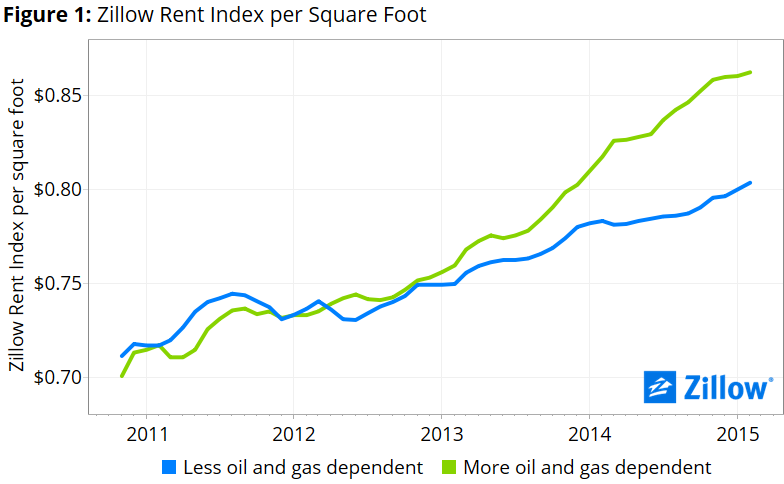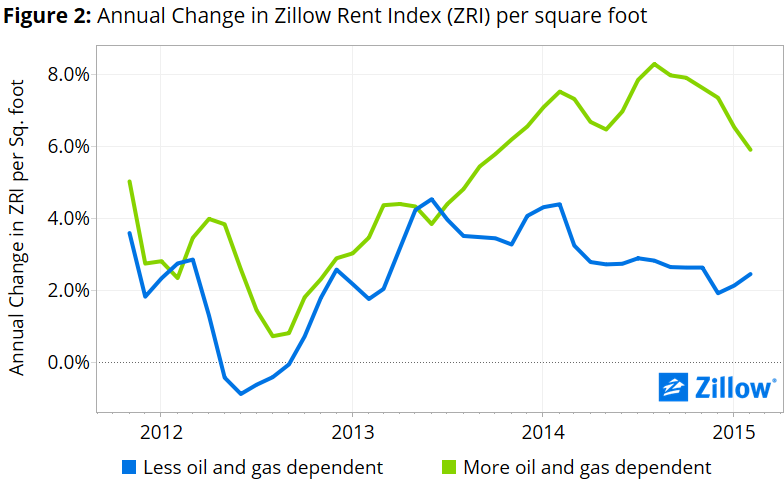- Over the past six months, the growth rate of rents in more oil-dependent Texas metros has slowed from 8.3 percent annually in August 2014 to a 5.9 percent annual pace of growth in February 2015.
- This coincides with a roughly 50 percent decline in oil prices over a similar period, from slightly less than $100 per barrel in July 2014 to less than $50 currently.
 There are some striking differences beginning to emerge in Texas’ disparate rental markets, potentially fueled by a steep drop in oil prices.
There are some striking differences beginning to emerge in Texas’ disparate rental markets, potentially fueled by a steep drop in oil prices.
In Texas metros where oil-and-gas-industry workers represent a larger share of the total workforce (in this analysis: Midland, Odessa, Beaumont, Houston and Corpus Christi), rent growth has outpaced growth in less energy-dependent Texas markets (Austin, Brownsville, Lubbock, Dallas-Fort Worth and Amarillo)[i]. But rents in the more oil-and-gas-dependent metros have been coming back to earth very quickly as the industry struggles with currently very low oil prices.
On the eve of the most recent oil-and-gas boom, median rents per square foot were essentially identical in these two sets of metros. But beginning in 2013, rents have since increased much more quickly in metros where oil-and-gas workers represent a larger share of the workforce (figure 1).
 Rents are still growing more quickly in oil-dependent metros, but over the past six months, the growth rate of rents in these metros has slowed substantially – from an 8.3 percent annual pace of growth in August 2014 to a 5.9 percent annual pace of growth in February 2015. This coincides with a roughly 50 percent decline in oil prices over a similar period, from slightly less than $100 per barrel in July 2014 to less than $50 currently[ii]. In contrast, the per-square-foot growth rate of rents in metros that are less dependent on oil-and-gas industry workers has been relatively flat (figure 2).
Rents are still growing more quickly in oil-dependent metros, but over the past six months, the growth rate of rents in these metros has slowed substantially – from an 8.3 percent annual pace of growth in August 2014 to a 5.9 percent annual pace of growth in February 2015. This coincides with a roughly 50 percent decline in oil prices over a similar period, from slightly less than $100 per barrel in July 2014 to less than $50 currently[ii]. In contrast, the per-square-foot growth rate of rents in metros that are less dependent on oil-and-gas industry workers has been relatively flat (figure 2).
Previous research shows that roughly two-thirds of recent movers to Texas who came to work in the oil-and-gas industry were renters. They were also much more likely to be well-educated, have high incomes and opt to live in pricier apartment buildings. There remains substantial uncertainty about how long oil prices will remain low, and how and when this could spill over into local labor and housing markets. But the data are clearly beginning to show that recent breakneck growth in Texas rental markets is starting to slow.
[i] Shares taken from Zillow analysis of data from a pooled sample of 2012 and 2013 American Community Survey (ACS) data made available by the University of Minnesota, IPUMS-USA. We include workers in five industries: Oil and gas extraction (0370); support activities for mining (0490); petroleum refining (2070); miscellaneous petroleum and coal product manufacturing (2090); and construction and mining and oil and gas field machinery manufacturing (3080). This is only a very narrow subset of workers supporting the oil-and-gas industries.
[ii] Source: Nasdaq end-of-day commodity futures price quotes for West Texas Intermediate crude oil, accessed March 25, 2015.